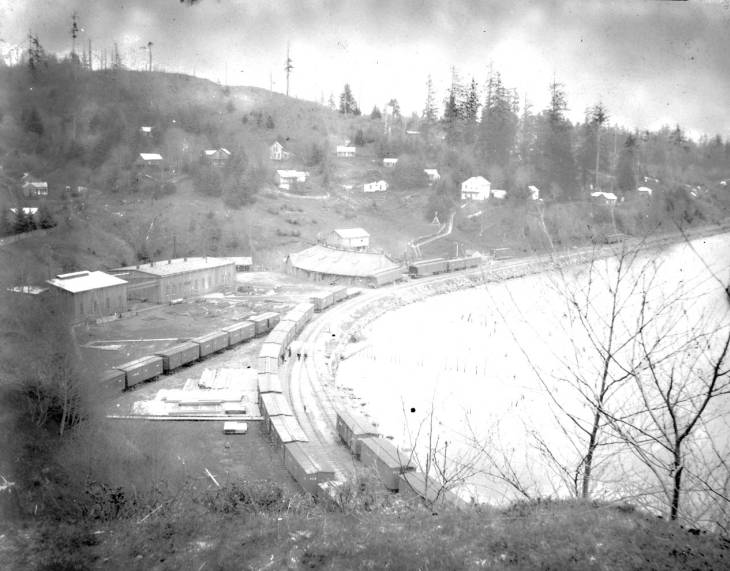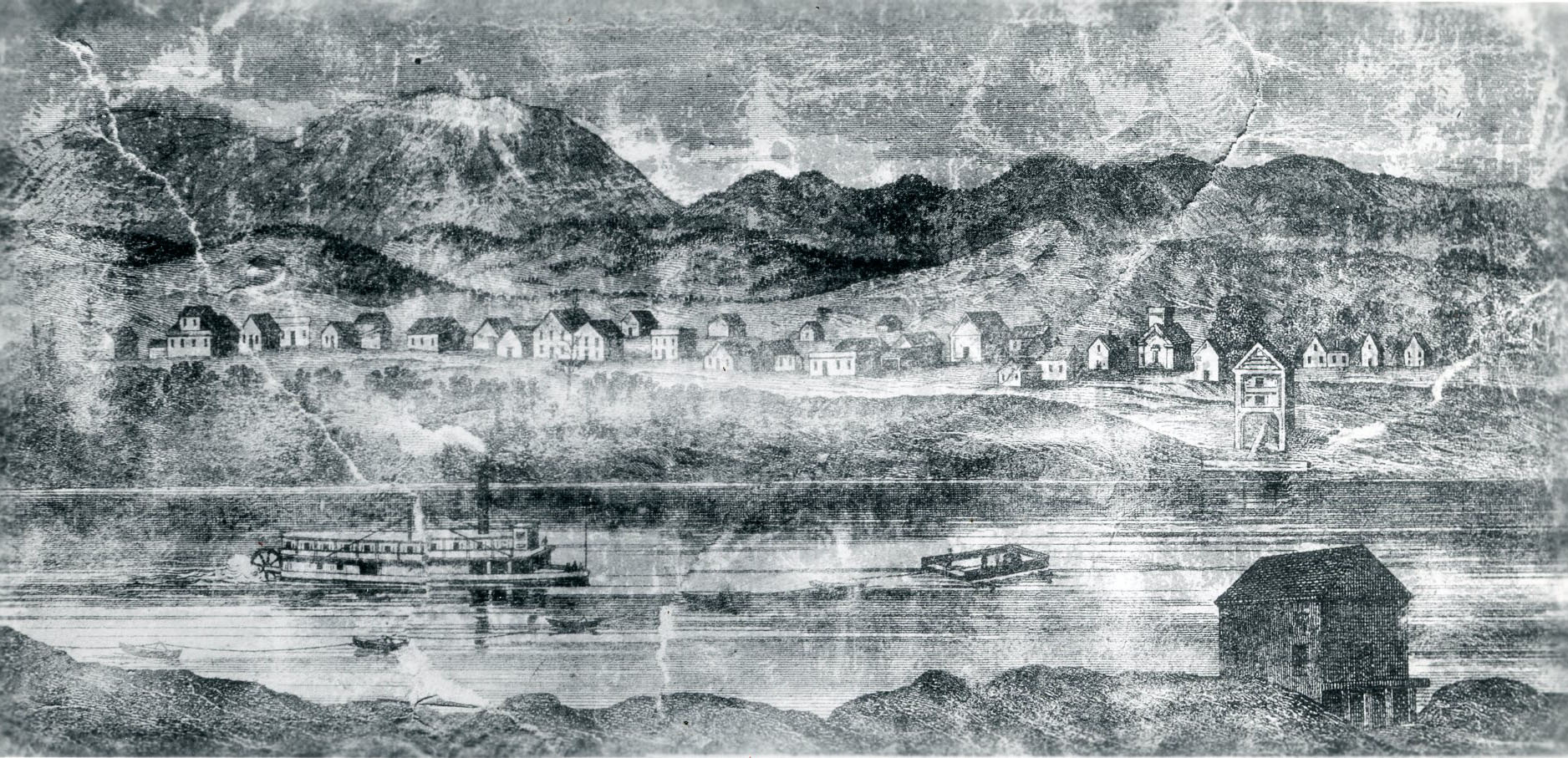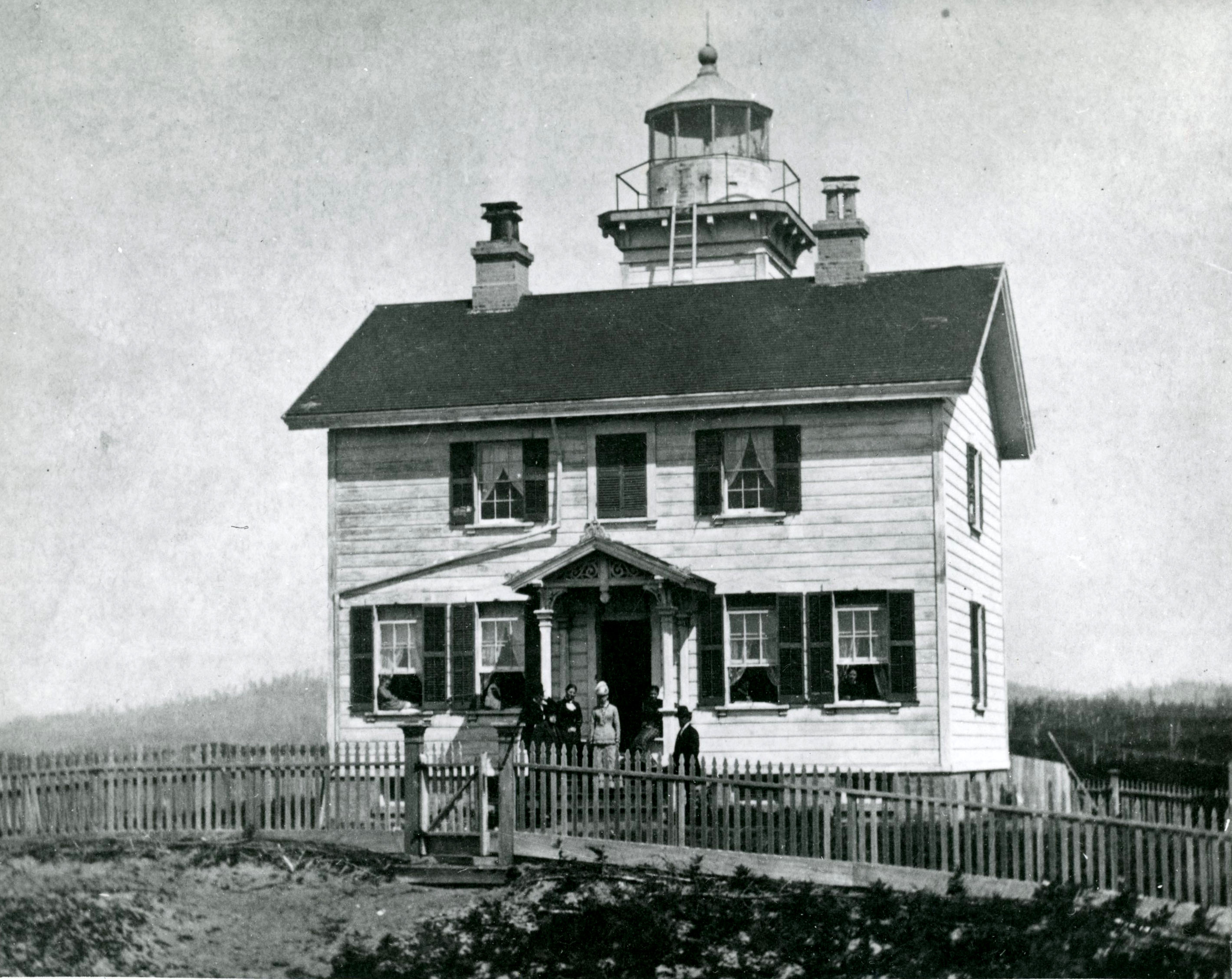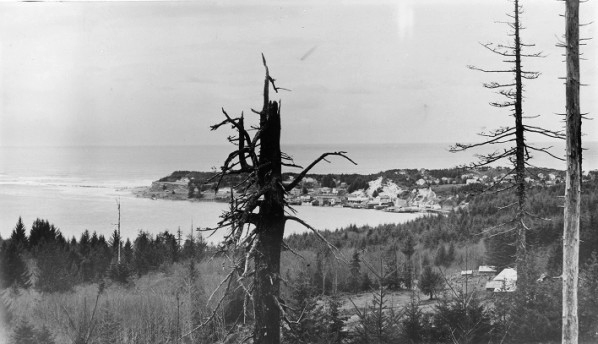Yaquina City was a railroad boomtown on the upper reaches of Yaquina Bay, three to four miles east of Newport on the central Oregon Coast. The briefly flourishing town illuminates many of the challenges of late nineteenth-century coastal transportation by rail and by sea.
Railroad promoter Thomas Egenton Hogg founded the town in the 1880s as the terminus of his promised railroad line between Corvallis and the coast. A forty-three-year-old merchant from Baltimore, Hogg moved to Corvallis in 1871 and incorporated the Corvallis & Yaquina Bay Railroad in 1872. Two years later, he incorporated the Willamette Valley & Coast Railroad to build a longer, narrow gauge line that would extend into eastern Oregon.
Capital was scarce, however, so Hogg and several investors incorporated Oregon Pacific Railroad in 1880 as the financing guardian of the Willamette Valley & Coast Railroad. Hogg proposed to follow the route of the existing Corvallis and Yaquina Bay Wagon Road, built in the 1860s, and acquired tide and marsh land grants from the state to help finance the railroad. Ultimately, he floated the idea of Corvallis as the center of a transcontinental railroad—routed over the steep and dangerous Cascade Mountains—from which commercial traffic would sail out of Newport for San Francisco, avoiding the long transshipment to Portland. Corvallis residents enthusiastically supported the plan. The only part of the scheme that became reality, however, was the railroad from Corvallis to Yaquina Bay. Construction began in September 1881, with Chinese laborers doing the majority of the construction work, and the first train arrived in Yaquina City in March 1885.
Hogg owned all of the land along the north bank of Yaquina Bay to Newport, and it is unclear why he decided to establish Yaquina City as the railroad terminus rather than continue his line to Newport. One account contends that Hogg offered Newport some $50,000 for land on the bayfront to build docks and warehouses for his enterprise, but was turned down.
Yaquina City flourished during the 1880s. The town began its boom period in about 1882, when entrepreneurs from Newport established businesses there. The post office opened in 1885, and Collins van Cleve moved to Yaquina City from Newport in 1882 to start the Yaquina Post, which he published for fourteen years. The town boasted a bank, two schools, hotels, several grocery stores, restaurants, a dry goods store, at least seven saloons, salmon canneries, a sawmill, and two churches. With some two thousand residents by the 1890s, it was the largest population center in Lincoln County. The first meeting of the Oregon Newspaper Publishers Association and several meetings of the Oregon Pharmacological Association convened there, and there was even a short-lived Yaquina University. The Lincoln County Leader reported on January 10, 1895, that the school’s second term had begun that month, “for the thorough teaching of young ladies and gentlemen.”
Poor investments and miscalculations about maritime commerce opportunities eventually led to the town’s downfall. The railroad suffered several accidents, probably because of mismanagement or lack of capital for repairs. Then there were the accidents to Hogg’s steamers, used for local transport. After the Yaquina City went aground while entering Yaquina Bay in December 1887, Hogg chartered the City of Topeka and renamed it Yaquina Bay. In December 1888, the steamer rammed against the south jetty, broke up, and sank. These incidents frightened investors away.
There were larger transportation problems as well. Yaquina Bay, only fifteen feet deep before dredging, could not accommodate large ships headed to San Francisco. Most Willamette Valley commercial traffic used railroad lines to Portland and then steamers on the Columbia River, modes of transportation that the central coast could not use effectively, even with shortened route times to California.
By the mid-1890s, Yaquina City’s boom days were over. On the night of March 26, 1901, a fire destroyed most of the town’s business district, which was never rebuilt. There was a brief boost in 1918, when the U.S. Army’s Spruce Division used the city’s docks as a shipping terminus for supplies needed to build the Toledo spruce mill. The railway between Yaquina City and Toledo was abandoned in 1937, and the decline continued, though fortunes briefly revived when the railroad bed was graded and turned into a road.
Highway 101, built in the 1920s, bypassed Yaquina City for Newport, sounding Yaquina City’s death knell. Pete Rasmussen opened a store in Yaquina in 1946 and expanded it in 1947 for vacationers, but the town was long gone. The post office closed in 1958. Yaquina Pete’s Place became a local landmark and flourished until the 1970s. The building, sold in 1975, became the Mad Dog Tavern.
-
![]()
-
![]()
Construction of Yaquina City, 1891.
Courtesy Salem Public Library Historic Photograph Collections, Salem Public Library, Salem, Oregon -
![]()
-
![]()
Timber yard, Yaquina, c.1918.
Courtesy Oregon Hist. Society Research Lib., Org lot 1062
-
![]()
Equipment and supply yard, Yaquina, c.1918.
Courtesy Oregon State University Librares, Siuslaw National Forest, A.M. Prentiss -
![]()
Thomas E. Hogg.
Courtesy Oregon and her Resources, 1877
-
![]()
Oregon Pacific Railroad Map with proposed railroad and steamship routes along the coast, Willamette River, and eastern Oregon, c.1880.
Courtesy Oregon Hist. Society Research Lib., G4241.P3.1880.073
-
![]()
Related Entries
-
![Corvallis]()
Corvallis
Nestled on the west side of the mid-Willamette River, Corvallis is domi…
-
![Corvallis and Eastern Railroad]()
Corvallis and Eastern Railroad
Built in the 1870s by T. Egerton Hogg in a fit of over-opportunistic bo…
-
![Spruce Production Division]()
Spruce Production Division
In 1918, during World War I, almost thirty thousand U.S. soldiers were …
-
![Yaquina Bay Lighthouse]()
Yaquina Bay Lighthouse
Yaquina Bay Lighthouse, built in 1871, is currently the only wooden lig…
-
![Yaquina Bay Oyster War]()
Yaquina Bay Oyster War
Yaquina Bay, an estuary on the central Oregon Coast, was once home to t…
Map This on the Oregon History WayFinder
The Oregon History Wayfinder is an interactive map that identifies significant places, people, and events in Oregon history.
Further Reading
Gavin, Scott M. Empire of Dreams: The Story of the Oregon Pacific. Toledo, OR: Yaquina Pacific Railroad Society, 2016.
Moe, Ray T., ed. One Hundred Years in Lincoln County, Oregon. Newport, OR: Lincoln County Centennial Committee, 1993.
Scott, Leslie M. “The Yaquina Railroad: The Tale of a Great Fiasco.” Oregon Historical Quarterly 16 (September 1915): 228-245.
“Yaquina Bay, Oregon.” The West Shore, August 1, 1889.
“Yaquina.” Weekly Corvallis Gazette, May 9, 1884.
Wike, Pat Chambers. “The Memories of Yaquina City.” History of Lincoln County, no. 7 (March 1976). On file at the Lincoln County Historical Society, Newport, OR.
Wyatt, Steve M. “Yaquina: The Lost City.” The Bayfront, May 1999. On file at the Lincoln County Historical Society, Newport, OR.













